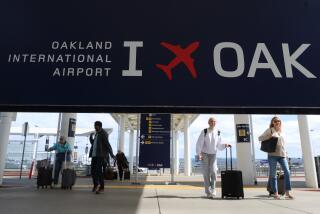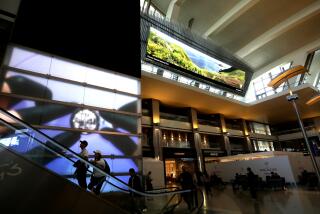Plenty of Turbulence
SAN JOSE â âLarry-and-the-airport.â Thatâs the shorthand. The conflict has gone on for so long that shorthand is enough. Sometimes the words come with a chuckle, as in, âThat kooky Larry-and-the-airport.â Sometimes theyâre bitter. (âThat #$@!-ing Larry-and-the-airport.â) Sometimes they connote an epic standoff, though Larry-and-the-airport is, at its most basic, just a court case in which a ruling is expected any day now.
Larry is Larry Ellison, founder and chief executive of Oracle Corp. and the nationâs second-richest person. The airport is little San Jose International, where Ellison keeps his Gulfstream V. And--for the benefit of those who may not have kept up with the past three years of mutual nose-thumbing--the former has taken the latter to federal court on a question that now threatens the sleep of some 10,000 airport neighbors: whether Ellison should be allowed to fly in and out of San Jose whenever he wants.
The larger issues are familiar to any metropolis where working stiffs cross paths with jet-setting moguls. In San Jose, however, that situation seems to have happened overnight. Take, for example, the local airport curfew, which was drawn up when San Jose was a much sleepier city. Intended to prevent most planes from taking off or landing between 11:30 p.m. and 6:30 a.m., the 17-year-old curfew is unusual in that it is weight-based, covering aircraft weighing more than 75,000 pounds.
Ellisonâs $38-million Gulfstream V weighs 90,500 pounds with its tank full. Once, that greater size might have meant a noisier plane. But because of aeronautical advances in the past two decades, the Gulfstream makes only a fraction of the noise made by older but lighter--and thus exempt--aircraft. Ellison has asked for an exemption, saying the noise ordinance discriminates against his quiet airplane. For a variety of reasons, however, the city has refused to accommodate the goateed billionaire and the jet with deep leather seats and birdâs-eye maple paneling.
One reason is political. Four years ago, as Silicon Valley boomed and demand for flights in and out of it burgeoned, San Joseâs curfew became key to a drive to expand the airport. The expansion, which is still wending its way through the regulatory gantlet, was approved by the city in 1997, but only after city officials vowed to more aggressively enforce the existing noise curbs.
Mayor Ron Gonzalez was elected on a campaign to crack down on airplane noise. And on June 25, 1998--shortly after Gonzalez took office--Ellison started flying in and out of San Jose after hours. No fines are attached to the curfew; the city had mainly dealt with violators by firing off letters and threatening to get court orders. Ellison and his corporation, Wing and a Prayer Inc., which is the planeâs owner, got seven letters from the airport in nine months.
Ellison ignored them. The city sent more letters. Down on the flight path, where civic boosters were scrambling to make San Jose synonymous with Silicon Valley, homeowners howled that the tech big shot was getting special treatment. The San Jose Mercury News egged things on, pointedly noting âSan Joseâs reluctance to confront one of Silicon Valleyâs richest men.â
âOn Monday,â a Dec. 21, 1999 news story jeered, âcity officials really let [Ellison] have it: They held a committee meeting.â The city, however, found that its options were limited.
For example, enforcement was tricky. A federal law passed in 1990 grandfathered existing local curfews (adopted before that date), and restricted cities from enacting new ones. San Joseâs curfew already was being challenged by small-plane owners and other aviation enthusiasts.
Nor could the city just wink at Ellisonâs transgressions. Officials said that if they let Ellisonâs jet fly late, they would have to do the same for commercial aircraft with similar noise levels. âOne exception for one Gulfstream V would open the door for a couple dozen more flights a night,â said the mayorâs spokesman, David Vossbrink. Even quieter jets can be a nuisance when dozens are flying over a neighborhood at bedtime. Not even U.S. Sen. Joe Lieberman, when he was running for vice president, got a curfew exemption: When he stayed too late at a Silicon Valley fund-raiser, the airport told him to sleep over and fly out in the morning.
Some suggested changing the curfew ordinance, but federal law effectively prohibits amending the curfew without voiding it. Others pointed out that Ellison--whose jet is the only private plane of its size to be based at the San Jose airport--could have avoided the problem simply by using nearby airports in Oakland or San Francisco. But San Francisco is chronically fog-bound and Oakland is more than an hour by car from Silicon Valley. Plus, San Jose has the best corporate jet center and--well, simplicity is not part of the Ellison style. When Ellison strode to the podium at the last Comdex trade show, he was flanked by security guards, ZZ Top was blasting from the sound system and he was laughing with reporters about a wild Internet rumor that he had just died in a fiery plane crash in the parking lot at Oracle headquarters.
While the airport fight was building, Ellison was caught hiring a gumshoe to spy on a pro-Microsoft trade group; had a public falling out with his longtime corporate lieutenant; was sued (unsuccessfully) by a Florida yacht broker who claimed Ellison cheated him out of $700,000 in sales commissions; was accused of faking the smog certificate on his McLaren F1 sports car; and was contacted by police because his fired housekeeper had been caught pawning his stolen Rolex.
Ellison, in short, is not the sort to go gently. âItâs wacky,â he said of the curfew when a TV reporter corralled him at a software conference in late 1999 in San Francisco. âSan Jose has no right to tell me when to land my airplane. [The airport] is federal property and itâs a federal issue.â The remarks created such a ruckus in San Jose that since then, Ellison has declined to comment on the airport. But 2 1/2 months later in January 2000--as the city continued to pelt him with warning letters--he called San Joseâs bluff and sued.
âHe got tired of being called a scofflaw,â Ellisonâs lawyer, Edward P. Davis Jr., said last week. âThe city kept sending these notices and we kept explaining why we thought the G-five [jet] satisfied their requirements, and they kept rejecting our arguments and threatening to kick the airplane out of the hangar and calling press conferences to say bad things about Larry Ellison. We just decided to go to court and settle it once and for all.â
The mogul asked the court to enjoin the city from enforcing its curfew against his Gulfstream; the city has since asked that Ellison be enjoined from taking off and landing after hours. Now, after more than a year of argument, the matter rests before U.S. District Court Judge Jeremy Fogel, who warned the city last month that, if he were to end up making the call, the noise question will be left up to federal regulations, which are not weight-based and âit may be that the airport doesnât have a curfew anymore.â
âI blame both sides,â fumed Kathleen Cahill, a 37-year-old teacher who lives near the airport in a bungalow âabout the size of Larry Ellisonâs bathroom.â
âLarry Ellisonâs an immature ass who wants to have everything his way. But the city was stupid for making the rules the way they did.â Her consolation, she says, is that if the curfew goes, so might the popular support for San Joseâs airport expansion. Maybe then, she says, the city will snap out of its fixation with the civic big leagues.
âIâm sick of the city thinking of us always as Silicon Valley now, and never as just Santa Clara County,â she said, summing up the adjustment that, in so many ways, is what people here really mean when they talk about âLarry-and-the-airport.â
âIâm sick of it being that, if youâre not high-tech here, you basically donât count.â
More to Read
Inside the business of entertainment
The Wide Shot brings you news, analysis and insights on everything from streaming wars to production â and what it all means for the future.
You may occasionally receive promotional content from the Los Angeles Times.






